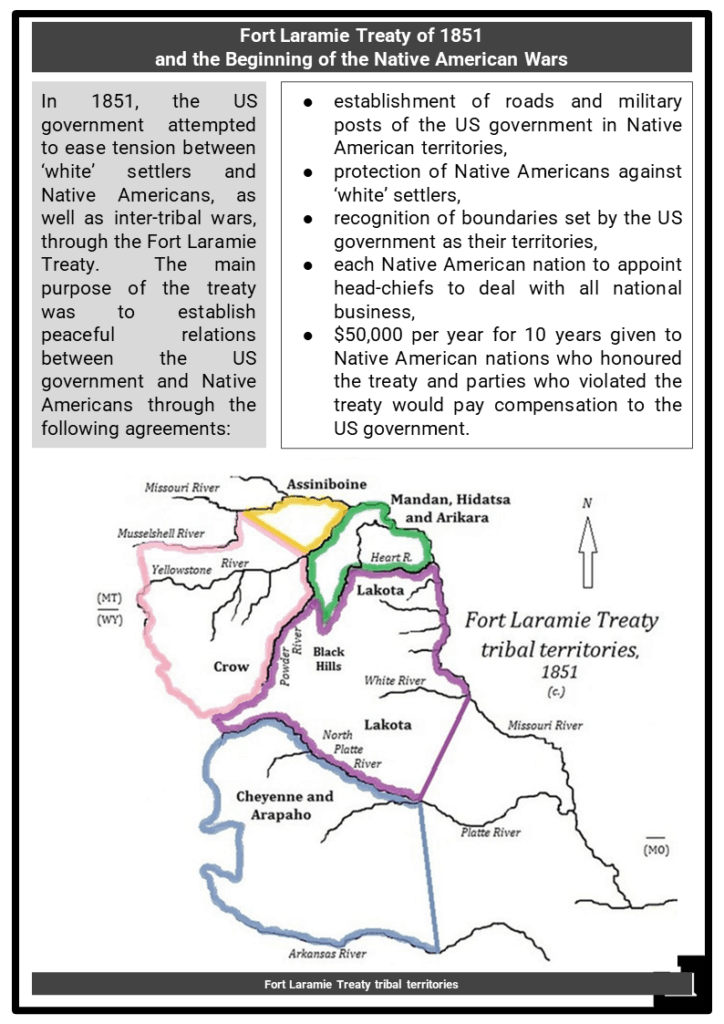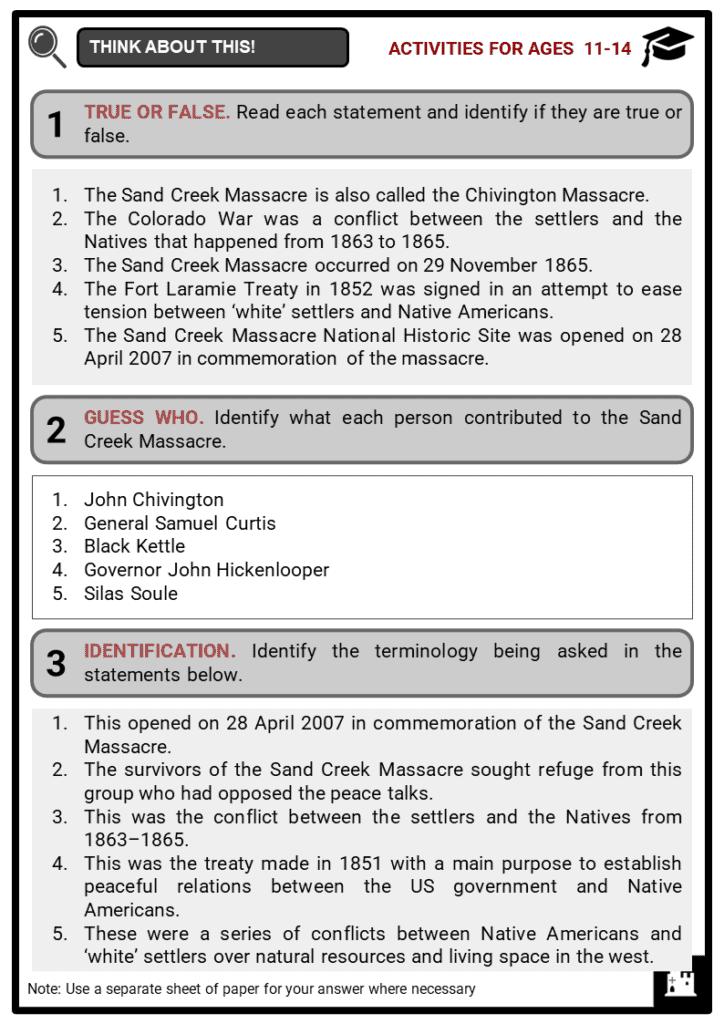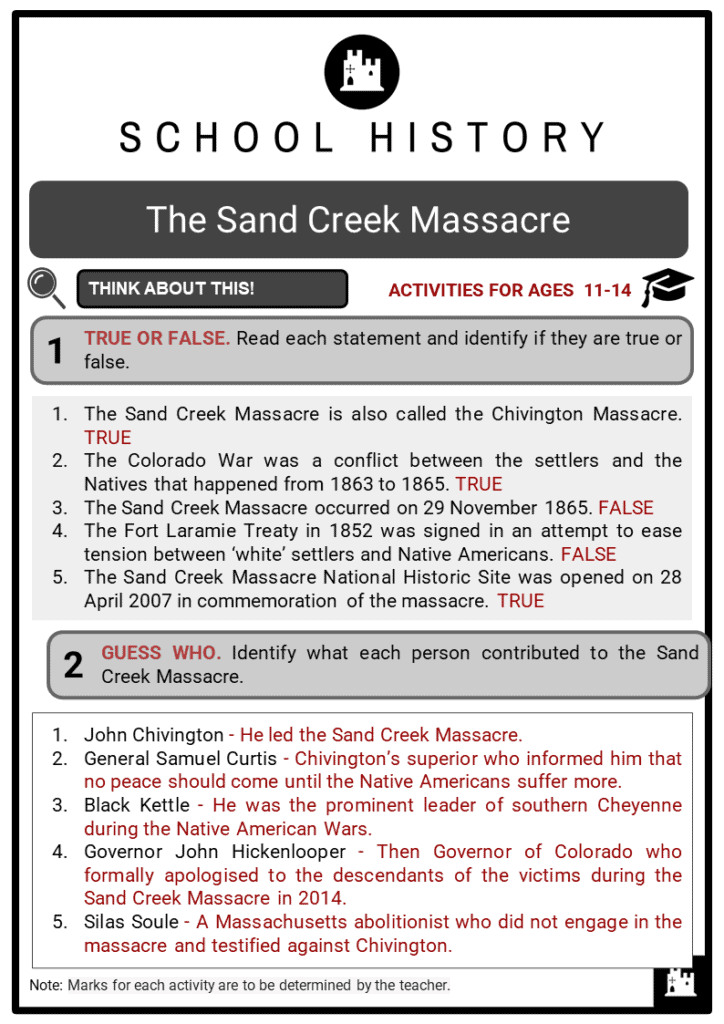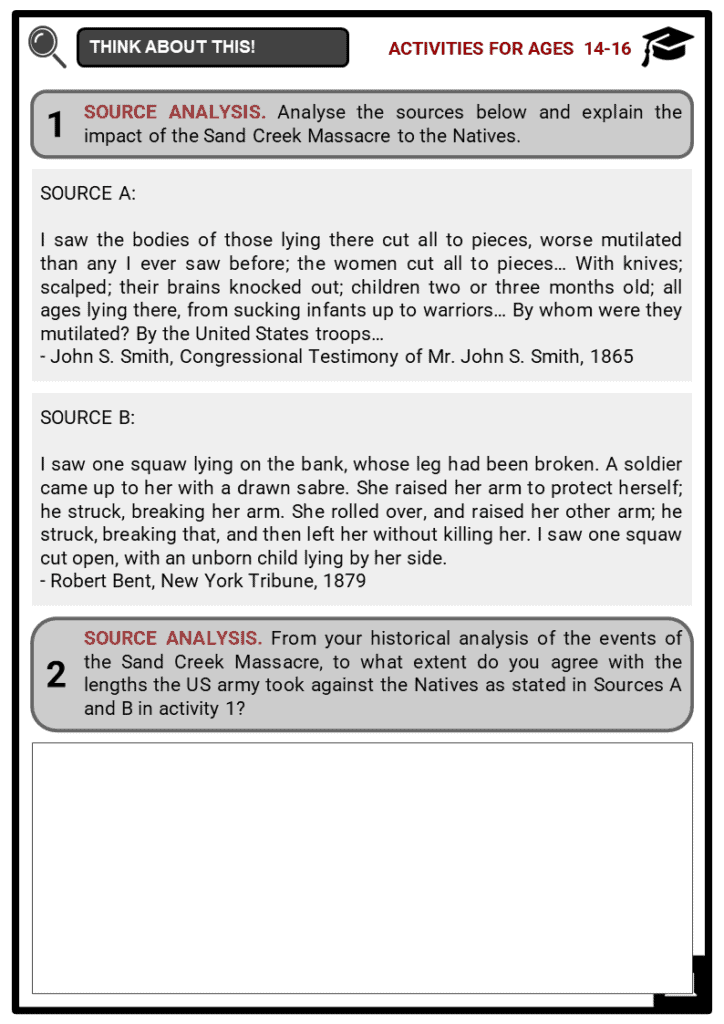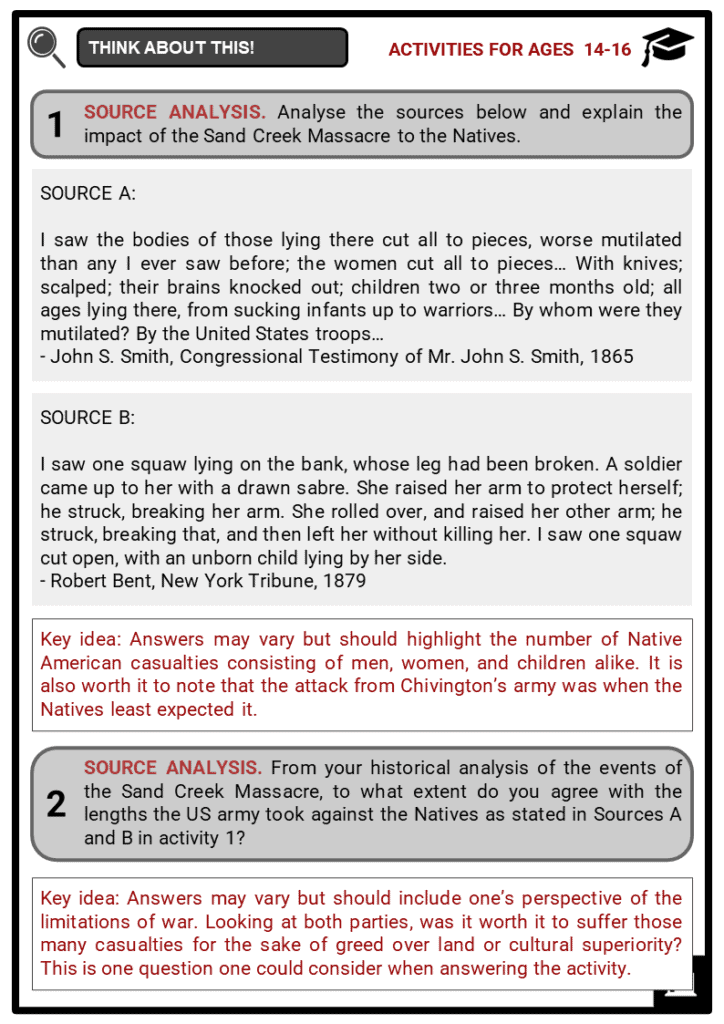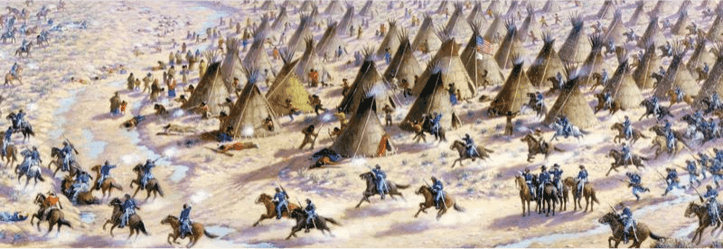Download The Sand Creek Massacre Worksheets
Do you want to save dozens of hours in time? Get your evenings and weekends back? Be able to teach The Sand Creek Massacre to your students?
Our worksheet bundle includes a fact file and printable worksheets and student activities. Perfect for both the classroom and homeschooling!
Table of Contents
Add a header to begin generating the table of contents
Summary
- Fort Laramie Treaty of 1851
- The beginning of the Native American Wars
- Sand Creek Massacre: The attack on the Cheyenne
- Official investigations on the massacre
- Aftermath and legacy
Key Facts And Information
Let’s find out more about The Sand Creek Massacre!
- The Sand Creek Massacre was a dreadful crime committed under the leadership of John Chivington against Native Americans, particularly the Cheyenne and Arapaho people, who had surrendered after a peace deal. Chivington was never brought to justice for his crime during the massacre including the murder of Silas Soule who testified against him during a Congressional inquest into the massacre. Years after the tragic event, a National Historic site was erected to commemorate the years of dispute surrounding the facts of the massacre.
Fort Laramie Treaty of 1851 and the Beginning of the Native American Wars
- In 1851, the US government attempted to ease tension between ‘white’ settlers and Native Americans, as well as inter-tribal wars, through the Fort Laramie Treaty. The main purpose of the treaty was to establish peaceful relations between the US government and Native Americans through the following agreements:
- establishment of roads and military posts of the US government in Native American territories,
- protection of Native Americans against ‘white’ settlers,
- recognition of boundaries set by the US government as their territories,
- each Native American nation to appoint head-chiefs to deal with all national business,
- $50,000 per year for 10 years given to Native American nations who honoured the treaty and parties who violated the treaty would pay compensation to the US government.
- Attended by representatives of the US Government and Native Americans, including the Arapaho, Cheyenne, Crow, and Sioux, the treaty was signed on 17 September 1851. As a result, Native Americans promised not to attack migrating ‘white’ settlers on the Oregon Trail. In return, each nation would be provided with hunting areas.
- Many thought that the “Native American problem” was solved by the policy of concentration, but it only lasted for a few years due to a number of problems. As the treaty was written in English, there was no assurance whether the tribes fully understood the clauses. There were not enough interpreters to ensure such understanding. Clashes with the Native American custom of consensual decision-making versus elected representatives of the US government appointing tribal chiefs.
- Despite some misunderstandings, peace on the Great Plains followed after the treaty. The California and Oregon Trails were travelled by over 250,000 people between 1840 and 1860 with almost no casualties from conflict. However, it was disrupted by the developments below:
- By 1854, the US government had not intervened in the growing movement of settlers to Kansas and Nebraska.
- With the discovery of gold in the Rocky Mountains in 1858, the Colorado Gold Rush began and about 100,000 settlers and miners populated Colorado and Kansas (parts of the Native American territory).
- In 1858, land surveyors began to search for railroad routes across the Great Plains to form organised transport links, particularly between Missouri and California.
- Despite the cooperation of several chiefs, there were a number of bands who did not adhere to the agreement and remained warriors in spirit and practice.
- Due to these problems, the Native American Wars began. These were a series of conflicts between Native Americans and ‘white’ settlers over natural resources and living space in the west. Conflict between the two groups heightened as ‘white’ settlers flooded the Great Plains after the discovery of gold and relentless westward expansion.
Sand Creek Massacre
- The Sand Creek Massacre, also called the Chivington Massacre, which occurred on 29 November 1864, is among the infamous events of the Native American Wars. The gold and silver rushes of the 1850s were instrumental in driving settlements in the Rocky Mountain regions and surrounding areas. The Cheyenne and Arapaho were forced to give up their land in favour of European settlers until 1858 at the Pike’s Peak Gold Rush when the Natives became tired of the European greed for their land.
- The Natives began retaliating by attacking wagon trains, stagecoach lines, and mining camps, mainly during the Civil War when the presence of the military in the region had significantly reduced. The conflict between the settlers and the Natives was later called the Colorado War of 1863–1865.
- John Chivington reinforced his militia and they referred to themselves as the “Hundred Dozers”. The Cheyenne and Arapaho were tired of the war and were ready for peace. They, therefore, sent representatives to meet with Chivington and his militia representatives at Camp Weld, outside Denver, on 28 September 1864. Though no peace treaty was signed, the Native Americans decided a meeting near the army post was an indication declaring peace and sanctuary.
- However, during the peace talks, Chivington received communication from his superior General Samuel Curtis informing him “I want no peace until the Indians suffer more. No peace must be made without my directions.” Black Kettle, the prominent leader of the southern Cheyenne, travelled south with 550 Cheyenne and Arapaho and camped on Sand Creek under the promised protection of Fort Lyon, and those who were against the peace deal went ahead north to join the Sioux.
- With full knowledge of the Native American surrender, Chivington and his army of 700, most of whom were drunk, went out to Sand Creek. The Chief displayed an American flag and a white flag over his teepee in a sign of peaceful surrender. Chivington’s men attacked, killing all the Native American men, women, and children who did not manage to escape. They mutilated and scalped many, including pregnant women, and children, and divided their possessions among themselves.
- The attack was considered a form of treachery. Despite being praised initially, Chivington resigned from the military. Remarkably, Black Kettle survived the attack and continued with his peace mission. A year later, Cheyenne and Arapaho Native Americans accepted the new reservation in the Native American Territory.
Official Investigations
- Initially, the press reported the Massacre as a victory against the Cheyenne, but eyewitness accounts gave a different story of the events. Silas Soule, a Massachusetts abolitionist and his Calvary who did not engage in the massacre, testified against Chivington. He was murdered by Charles W. Squires who is believed to have been given the order by Chivington.
- The survivors of the massacre sought refuge to the Cheyenne Dog Warriors who had opposed the peace talks. Many of the Native Americans devoted themselves to fight the ‘white’ settlers, which ultimately resulted in the defeat and death of the majority of the natives. The massacre is also a direct result of the Little Bighorn battle. Though the Congressional inquest concluded that heinous crimes had been committed, Chivington and his crew were never brought to justice over the massacre.
- Almost 142 years after the massacre, the site on Big Sandy Creek in Kiowa County was preserved by the National Park Service. The Sand Creek Massacre National Historic Site was opened on 28 April 2007 in commemoration of the massacre. 640 acres of Sand Creek was preserved and deeded to the national historic site by the American Battlefield Trust and its partners.
- In 2012, an exhibit about Sand Creek opened in Denver but it closed a year after because of the criticisms it received from the Northern Cheyenne Tribe.
- On 2 December 2014, then Governor of Colorado John Hickenlooper formally apologised to the descendants of the victims during the Sand Creek Massacre. He stated, “We should not be afraid to criticize and condemn that which is inexcusable... On behalf of the State of Colorado, I want to apologise. We will not run from this history.”
- In 2015, construction of a memorial to the Sand Creek Massacre victims began on the Colorado Capitol grounds.
Image sources:


